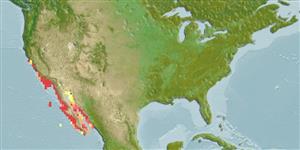ກຸ່ມປາກະດູກອ່ອນ (ເຊັ່ນ: ປາສະຫລາມ, ປາຜາໄລ) (sharks and rays) >
Torpediniformes (Electric rays) >
Platyrhinidae (Fanrays)
Etymology: Platyrhinoidis: Greek, platys = flat + Greek, rhinos = nose + Greek, oides = similar to (Ref. 45335).
More on authors: Jordan & Gilbert.
Environment: milieu / climate zone / depth range / distribution range
ນິເວດວິທະຍາ
ສັດທະເລ ອາໄສຢູ່ໃກ້ໜ້າດິນໃຕ້ພື້ນທ້ອງນ້ຳ; ລະດັບຄວາມເລິກ 0 - 137 m (Ref. 96339). Subtropical; 38°N - 23°N, 124°W - 108°W (Ref. 114953)
Eastern Pacific: San Francisco, USA to Baja California, Mexico.
Length at first maturity / ຂະໜາດ / ນ້ຳໜັກ / Age
Maturity: Lm ?, range 48 - ? cm
Max length : 91.0 cm TL ຕົວຜູ້/ບໍ່ມີເພດ; (Ref. 2850)
Inhabits fine sand to mud bottom, often near kelp beds and sometimes abundant on mud flats of coastal bays. Often buries itself in bottom sediments. Ranges from the intertidal zone to 50 m depth (Ref. 12951). Solitary or in small groups, gathers in shallow bays, lagoons, and off beaches (Ref. 12951, Ref. 114953). Feeds on small sand-dwelling crustaceans, worms and mollusks. Ovoviviparous (Ref. 50449), with 1 to 15 pups in a litter (Ref. 48844), mainly in August (Ref. 114953). Possesses ampullary electroreceptors with a region of maximum sensitivity of 5-15 Hz (Ref. 10011).
Exhibit ovoviparity (aplacental viviparity), with embryos feeding initially on yolk, then receiving additional nourishment from the mother by indirect absorption of uterine fluid enriched with mucus, fat or protein through specialised structures (Ref. 50449).
Eschmeyer, W.N., E.S. Herald and H. Hammann, 1983. A field guide to Pacific coast fishes of North America. Boston (MA, USA): Houghton Mifflin Company. xii+336 p. (Ref. 2850)
IUCN Red List Status (Ref. 130435)
Human uses
ເຄື່ອງມື
Special reports
Download XML
ແຫຼ່ງອີນເຕີເນັດ
Estimates based on models
Preferred temperature (Ref.
123201): 15.3 - 23.1, mean 20.6 °C (based on 38 cells).
Phylogenetic diversity index (Ref.
82804): PD
50 = 1.0000 [Uniqueness, from 0.5 = low to 2.0 = high].
Bayesian length-weight: a=0.01000 (0.00244 - 0.04107), b=3.04 (2.81 - 3.27), in cm total length, based on all LWR estimates for this body shape (Ref.
93245).
ຊັ້ນເຂດຮ້ອນ (Ref.
69278): 3.4 ±0.42 se; based on food items.
ຄວາມຢືດຢຸ່ນ (Ref.
120179): ຕຳ່ຫຼາຍ, ປະຊາກອນຕຳ່ສຸດທີ່ໃຊ້ເວລາສອງເທົ່າຫຼາຍກວ່າ 14 ປີ (Fec = 1).
Fishing Vulnerability (Ref.
59153): High vulnerability (56 of 100).
